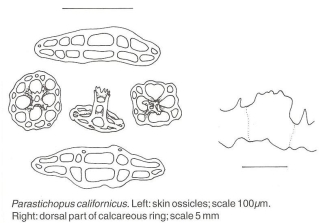Parastichopus californicus feeds as it moves randomly along the bottom; in one study, P. californicus moved up to 3.9 metres in a day. The mop-shaped tentacles of P. californicus are pressed onto the substratum and small particles adhere to the sticky surface. As the tentacle retracts toward the mouth, the edges curl in to grasp larger particles. The tentacle enters the mouth and releases the particles. The animal gets its nutrition from the organic material in the sediment, mostly bacteria and fungi. As with many sea cucumbers, Parastichopus californicus ceases feeding and becomes dormant from September to early March.
The separate sexes reach maturity after four years. They are reported to migrate to shallow water to spawn from late April to August. In Friday Harbor, Washington, most spawning is from late May to mid July. During spawning, the anterior third to half of the body rises off the bottom in a cobralike posture. Strings of white sperm or light orange eggs (mean diameter = 204 μm) pour from the gonopore just behind the dorsal tentacles. Fertilization takes place in open water and the free-swimming larva feeds on plankton for 35 to 52 days before settling to the bottom.
Few predators are known - although Parastichopus californicus reacts strongly to the Sunflower Star (Pycnopodia helianthoides). When touched by this sea star, P. californicus rears back and flexes violently, effectively escaping from the grasp of the sea star.
From late summer to March most specimens have no obvious internal organs. Early workers thought that the internal organs were eviscerated through the cloaca. Recent evidence, however, indicates that the animal resorbs the organs during the dormant phase, and regenerates them during the winter.
Several parasites and commensals have been reported for Parastichopus californicus. The flatworm, Anoplodium hymanae, inhabits the body cavity; another flatworm, Wahlia pulchella, is found in the upper intestine; the parasitic gastropod, Enteroxenos parastichopoli, attaches to the intestine as elongated coils; the parasitic snail, Vitriolina columbiana, attaches to the external surface and penetrates the skin to suck the internal fluids and the commensal scale worm, Arctonoe pulchra, crawls on the skin among the papillae or tube feet.
Parastichopus californicus is harvested commercially in British Columbia, Washington and Alaska. In 1987-88 the volume of landings reached a peak of 1922 tonnes of whole animals in B.C. A coast-wide quota of 1500 tonnes was set from 1986-88, an area quota system from 1989 until 1995 and an Invidividual Quota system (IQ) was introduced in 1995. The total quota has been steadily reduced from the initial 1500 tonnes to 514 tonnes in 1995. In 1992 the landed value of the harvest was $1,363,000.00 and the wholesale value was $5,656,000.00. In 1994 the actual landings were 536 tonnes with a landed value of $976,000.00, based on an average price of $4.97 per kilogram of meat. The introduction of the IQ in 1995 may further reduce the total landings and help to safeguard the resource from overfishing.
|
